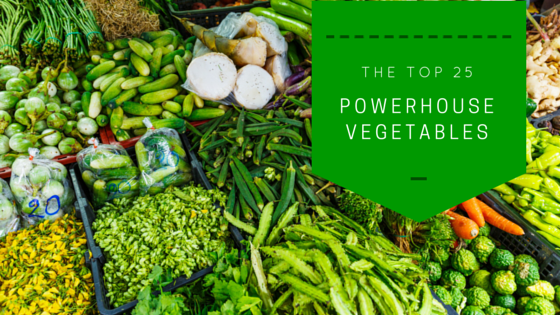What are Powerhouse Vegetables?
Powerhouse vegetables (and fruits) are strongly associated with a decrease in chronic disease risks but until recently, no studies had been conducted to determine which vegetables and fruits qualified as powerhouses. In a 2014 scientific article, author Jennifer De Noia, Ph.D. ranked 47 fruits and vegetables based upon their nutrient density. The 17 nutrients evaluated included; potassium, fiber, protein, calcium, iron, thiamin, riboflavin, niacin, folate, zinc, and vitamins A, B6, B12, C, D, E, and K. Unfortunately, due to a lack of reliable data on phytochemicals, these values were not taken into account during analysis. It’s important to note that Dr. Noia used data for the bioavailability of the nutrients, not just the total nutrient content. Bioavailability is simply the portion of a nutrient that is available to the body for use.
The Top 25 Powerhouse Vegetables
Why is kale so low on the list?
Yes, kale is a bit of a surprise, after all, it’s been touted as a “miracle tonic” and ranked as “one of the most nutrient-dense foods on the planet” by Joel Furhman, M.D. So what gives? Let’s go back to the beginning of this article. Remember, phytochemicals were not taken into account. Vegetables like kale that have high levels of beneficial phytochemicals may place lower on the list simply because these weren’t considered. Another thing to remember, Dr. Noia only included data on the bioavailable nutrients for each vegetable studied. The total nutrient levels could be higher in one vegetable than another but scored lower because the bioavailability of the nutrients was lower. Calories were also a factor in the choices made. The rankings were determined based on nutrients and calories per set weight, 100g in this case. For example, take watercress, the number one rated powerhouse vegetable, it’s very low in calories coming in at a mere 4 calories per cup!
Is there a bad choice?
Given the data, you simply can’t go wrong with incorporating any of these powerhouse vegetables into your diet. In fact, any of the top 41 that made the list would be excellent additions to your diet. We tend to eat diets lacking micronutrients and this can have a dramatic impact on our health. I’ve posted on this previously and you can read more about micronutrient deficiencies and chronic disease here. It’s important to find what you like and incorporate these powerhouse vegetables into your diet. Some are easier to eat than others. It’s probably easier for most of use to eat a cup or two of spinach than to eat a cup of scallions or chives! For these types of choices, it’s best to incorporate them into your recipes rather than eating them alone. But it is nice to know that whichever you choose, you’re getting a powerhouse punch of nutrients that your body will love.
Until next time, stay well!
Dr. Tobi Schmidt


